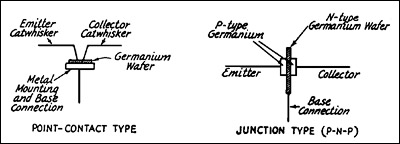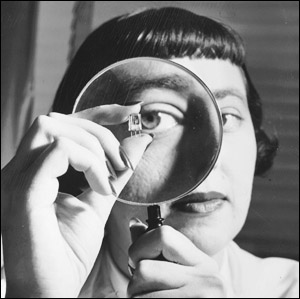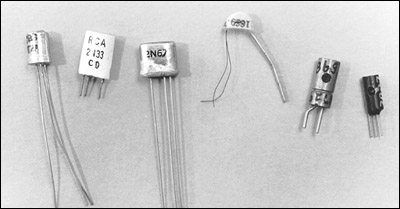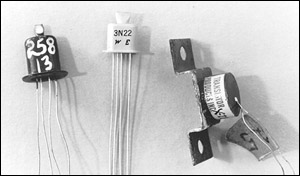BY JACK WARD --Web Edition
Jack Ward's carefully researched article reminds us that 1998 marks the 50th anniversary of the first public announcement of the invention of the transistor, which the April 1992 "Physics Today" said, "caused a revolution in technology and drastically altered society." The addition of Ron Blackshear's personal recollection of his friendship with John Bardeen, co-inventor of the transistor, gives us further insight into a remarkable 20th century event. (Editor)
On Wednesday, June 29, 1948, at the Bell Labs West Street headquarters in New York City, a press conference was held to announce the invention by Bell Labs scientists of a new amplifying device -- it was the transistor. The transistor had actually been invented 6 months earlier, December 1947, but the public announcement had been delayed to allow for filing of patents and disclosure to the military.
At the press conference, this new device was presented as an equivalent of the vacuum amplifier, except that it had desirable properties which overcame some of the fundamental drawbacks of tubes. For example, the transistor was small, lightweight, required no vacuum or filament current, and apparently had an unlimited lifetime. Although there were working demonstrations of the potential uses of the transistor presented to the audience (audio oscillator, audio amplifier, and radio receiver), no one present could have known or reasonably predicted the tremendous impact that this device would have on technology over the next 50 years.
FROM PROTOTYPE TO PRODUCTION
The transistor developed by Bell Labs in 1947 was of the type known as "point contact." This term refers to the technique used to attach two fine wires as points of contact to a germanium block, as shown in Figure 1. While this technique allowed for the discovery of transistor action, the resulting device was not ideally suited for large scale commercial usage -- the point contacts were erratic, mechanically unstable and yielded wide ranges of performance.
Nevertheless, Bell Labs continued to refine the techniques for point contact transistor development. By 1951, sufficient progress had been made to overcome some of the limitations of this type of transistor, and commercial production began at the Western Electric plant in Allentown, Pennsylvania.

Figure 1. A simplified illustration of the construction of point-contact and junction-type transistors.
(From "The Radio Amateur's Handbook" of the American Radio Relay League,1956, p. 79.)
By mid-1952, Western Electric was manufacturing 6,000 point contact transistors a month. This type of transistor was never in widespread commercial production, and found limited usage in the military, such as in the TRADIC airborne digital computer, and in Western Electric telephone switching equipment.
In July 1951, Bell Labs again made an announcement regarding transistors. This time a new type of transistor, called a "junction transistor," also shown in Figure 1, was made public. The junction transistor was constructed using a die or chip of germanium, with transistor action accomplished by any of several different manufacturing techniques, such as adding controlled amounts of impurities to the germanium -- the point contacts, with their inherent drawbacks, had been eliminated.
This new type of transistor was the basis for a large scale increase in the quantities of transistors manufactured by a variety of companies. For example, see RCA's "bean-sized" transistor, shown in Figure 2. In 1953, approximately 1,000,000 units were manufactured. In 1955, over 3,500,000 transistors were manufactured, and in 1957 almost 29,000,000 units were made. In ten years, the transistor had grown from an exciting laboratory prototype to a mass-produced technology which found uses in all kinds of products.

Figure 2. February 1952 -- One of RCA's laboratory technicians gives a final inspection of the strengthened version of its new transistor.
The device is about half the size of an ordinary paper clip. (United Press photo from the editor's collection.)
EARLY COMMERCIAL TRANSISTOR USES
The properties of the transistor -- small size, very long life expectancy, and no filament heater, which meant longer battery life and low heat output -- overcame the limitations of the vacuum tube. The transistor allowed for the rapid replacement of tubes in two very common electronic devices -- hearing aids and portable radios. Each of these devices could be made better with transistors.
The first hearing aids to use transistors appeared in 1953. Up to this point, hearing aids were manufactured with subminiature tubes, which were suitably small, but consumed expensive batteries at an alarming rate. The low-battery current requirements of transistors allowed for further size reductions in hearing aids (fewer batteries and those batteries lasted longer). Companies such as Maico and Sonotone introduced "all-transistor" or hybrid (transistor and tube) hearing aid models in 1953.
The first commercial, all-transistor portable radio, the Regency TR-1, was introduced by the I.D.E.A. Company in time for Christmas sales in 1954. The portable radio market capitalized on the same advantages of transistors that were important to hearing aids -- small size and low battery consumption. Although the TR-1 was not an instant sales success (probably because of poor fidelity and high cost), the transistor radio market rapidly expanded. By 1957, almost 5 million portable radios were manufactured and sold by a large number of American companies, such as Admiral, Arvin, Emerson, GE, Raytheon, RCA, Westinghouse and Zenith.
IMPORTANT TRANSISTOR MANUFACTURERS
By the end of 1957 approximately 20 companies were involved in the commercial manufacture of transistors. Most of these were large, well established electronic manufacturers. Two of these companies, Western Electric and Raytheon, dominated the early transistor industry; several other companies (GE, Texas Instruments, and Fairchild) made major contributions throughout the decade.
Western Electric and its research organization, Bell Labs, was the company responsible for the invention of the transistor. William Shockley, Walter Brattain, and John Bardeen jointly shared the 1956 Nobel Prize for Physics for inventing the transistor at Bell Labs in 1947. This work was the result of a semiconductor research group established after World War II at Bell Labs specifically to create a solid-state replacement for the vacuum tube. Western Electric actively promoted the new transistor technology in a variety of ways, including supporting continued research that led to the invention of the junction transistor in 1951, licensing transistor manufacturing rights to more than 30 companies for $25,000 each by 1952, and fostering the early use of transistors in commercial products by removing any royalty charges on transistors used in hearing aids.
Raytheon was the early commercial transistor technology leader, beginning with the CK703 point contact introduced in 1948. Moving quickly to the new junction technology, Raytheon was able to mass produce in such quantities that unit prices became attractive for hearing aid use -- the low- noise CK718, for example, was priced at $8 in volume quantities in 1953.
Having already established a leading role in the hearing aid market through the manufactureof subminiature vacuum tubes, Raytheon virtually created the transistorized hearing aid market, working closely with the established manufacturers to perfect product design. Raytheon continued to drive down costs, and the ever popular CK722 hobbyist type transistor dropped from $5 in 1953 to 99¢ by the end of 1955, as shown in the ad in Figure 6.
The 1,000,000th Raytheon transistor was manufactured in 1954, nearly 4 times the output of all other manufacturers combined. Raytheon continued to be a major semiconductor manufacturer throughout the 1950s, supplying devices in a variety of markets including commercial, military and hobbyist.
General Electric was active in the manufacture of transistors during the early 1950s. By 1953, GE had perfected a form of transistor manufacturing, called alloy junction, which allowed for reliable unit operation as well as relative ease of manufacturing. Types 2N43/44/45 were introduced in 1953 and found widespread industrial and military acceptance. It is common to find these types in surplus military equipment.
Texas Instruments (TI) was responsible for several important early transistor developments. In May of 1954, TI announced the commercial availability of the first silicon transistors, Models 900, 901 and X-15. This was several years ahead of most industry estimates regarding when silicon units would be available. Silicon transistors hadseveral advantages over the existing germanium type, most notably higher temperature stability. Silicon technology also was the basis for later semiconductor products, especially integrated circuits (IC) -- a combination of interconnected transistors and other components formed on a single semiconductor element. TI used this expertise to market the first ICs, called "Solid Circuit," in March, 1960, for $450 each.
Texas Instruments' other notable accomplishment was the TR-1 transistor radio mentioned earlier. Working with I.D.E.A. engineers, TI assisted in perfecting the radio design, initiating many new circuit and component innovations suitable for transistors. The radio used four TI transistors.
Fairchild Semiconductor was founded in September, 1957, by a group of eight engineer/scientists who had resigned en masse from William Shockley's Semiconductor Laboratories, Division of Beckman Instruments. Fairchild quickly became a technology leader in silicon transistor manufacturing, introducing the first units in 1958. These were high-speed, computer-switching units (2N696, 2N697) selling for over $100 each. Fairchild also invented a new manufacturing technique called planar, which became the basic technique for the manufacture of ICs. Fairchild became an early IC leader, introducing the "Micrologic" series of logic ICs for $120 each in 1961. Fairchild was also important in that most of the founding members of Fairchild left the company within a few years to start other successful semiconductor companies, the most notable of which is Intel.
GE continued to be a major manufacturer of transistors through the 1960s. In addition, GE pioneered the research and commercialization of several other unique semiconductor devices, introducing both tunnel diodes -- a special type of diode which can be used as an oscillator -- and silicon-controlled rectifiers or thyristors, which are bistable semiconductor devices designed in the late 1950s to be used as on/off switches.
LOOKING AHEAD TO THE 1960s
Transistor technology had made tremendous progress throughout the 1950s. The decade had started with this new device seen as an unreliable oddity, difficult to manufacture, but offering great potential. By 1960, there were 42 different U.S. firms manufacturing transistors, with almost 1,000 distinct models. By the end of 1961, sales of diodes, transistors and rectifiers reached $500 million, and the new integrated circuit technology, developed as a direct result of transistor research, was poised to achieve even higher unit and dollar levels.
COLLECTING HISTORIC TRANSISTORS
The process of identifying key collectible categories of historic transistors has not received much attention until recently, and so will likely expand as more collectors enter the field. As a general rule, only transistors manufactured between 1948 and 1960 are collectible. Other types of semiconductor devices, such as silicon point contact radar diodes from the 1940s, tunnel diodes from the late 1950s, and integrated circuits from the early 1960s make interesting additions to a transistor collection. The following categories can form the basis for starting an interesting and historically significant transistor collection:
- Point Contact Types. Any point contact type of transistor is collectible. This technology was in use only until about 1953, although a few replacement types were manufactured by Western Electric until the 1960s. Identifying a point contact unit can sometimes be difficult and requires comparing type numbers with historic reference lists. Some other types of point contact units are easily identified because there is a small hole on the unit to allow for manual adjustment of the point contacts during manufacture. Examples, some shown in Figure 8, include:
- Western Electric: 2N21, 2N23, 2N25, 2N26, 2N67, 2N110
- RCA: 2N32, 2N33
- CBS-HYTRON: PT-2A
- General Electric: G11
- Raytheon: CK703, CK716
-
- Early Bell Labs Units. Since most of the very early transistor work was done at Bell Labs, any prototype or production unit up to about 1953 is collectible. Usually these can be identified by comparing type numbers (sometimes handwritten on the case or container) with Bell Labs literature from that time period. As a bonus, there are a few units which were presented in commemorative boxes to attendees of early transistor seminars and conferences. An example includes a 1729X (example with handwritten model number, 1952/53)
- Early Prototypes or Non-Standard Technologies. Many companies experimented with the newly invented transistor technology by building prototype units. Most often the prototype units had handwritten identification. Additionally, a few companies experimented with "non-standard" technologies, such as 4-lead devices called "tetrodes" or light-sensitive units called "photo-transistors." Some of these types of devices were actually put into production. Examples, some shown in Figure 9, include:
- Western Electric: 3N22 (tetrode, 4-lead unit, 1956)
- General Transistor: GT66 (photo transistor, 1958)

Figure 8: These are somewhat rare point contact transistor types. From left to right: a CBS Hytron, CHY PT-2A of 1954;
an RCA 2N33 of 1953; a Western Electric 2N67 of 1954; a Western Electric 1689 of 1953; a Western Electric A1729X;
and a General Electric G11. Note the evidence of a small hole in the case of each of the last two units. This hole allowed for adjustment
of the fine point contact wires during manufacturing.
-
- Early Manufacturers in the Transistor Business for a Limited Time. Throughout the 1950s, a variety of companies entered commercial production of transistors, and then quickly exited within a few years. These were typically small companies or small divisions of large companies. Units from the following companies are quite rare and collectible:
- Transistor Products, Inc. (Div. of Clevite)
- Germanium Products, Inc.
- National Union
- Marvelco
- Hydroaire
- Radio Receptor
- Federated Semiconductor
-
- First or Early Production Units. As companies entered commercial production in the 1950s, specific model numbers or date codes can be identified as first or early production units. Examples include:
- Raytheon: CK718 (1st Raytheon junction type; production started in late 1952)
- General Electric: 2N43/44/45 (1st GE junction types; production started in 1953)
- Western Electric: A1858 (early junction type; production started in 1953)
- Western Electric: 1689, 1760, 1768 (production point contact units, 1953/54)

Figure 9. Unusual early junction transistors. Left to right: an experimental GE tetrode or 4-lead device, ca. mid-1950s;
a Western Electric 3N22, a production tetrode, ca. 1958; and a Transistor Products power transistor, ca. mid-1950s.
-
- Important Types Based On Underlying Unique Technology Or Intended Use. Some transistor types are collectible because the unit represents a unique technology -- early silicon units, for example -- or the unit was intended for a unique application, such as low-cost, experimenter usage. Examples include:
- Texas Instruments: 900/901/X-15 (First commercially available silicon units, 1954)
- Raytheon: CK722/721 (low-cost units aimed toward experimenter market, 1953)
- Western Electric: 2N559 (very high reliability switching unit for Nike/Zeus missile computer and communication systems, 1957)
- Philco: SB100 (early high frequency unit, Surface Barrier technology, 1955)
-
- Units With Unique Packaging, Text or Graphics. The external packaging (usually cardboard "matchbook-like" containers) used by several early transistor companies have collectible interest based on the uniqueness of the packaging or markings on the packaging. Examples include:
- Raytheon: (classic red/white/blue foldover cardboard package, 1954)
- General Transistor: (brilliant orange/black/white cardboard package, 1958)
- Western Electric: (early transistor terminology, "Crystal Unit, Amplifying" printed on white cardboard package, 1954)
-
REFERENCES AND FURTHER READING
Bell Labs Technical Journal, Vol. 2, No. 4, Commemorative Issue, "The Transistor -- 50th Anniversary: 1947-1997."
This is a collection of fairly technical articles describing early transistor developments and subsequent semiconductor engineering.
Electronic News, January, 25, 1982.
This issue celebrated 35 years of industry development following the invention of the transistor. It is full of interesting ads and short news pieces on various companies and products.
Physics Today. "John Bardeen." Special Issue, April 1992.
A series of informative talks about John Bardeen and his work given at the March 1992 American Physical Society meeting in Indianapolis, Indiana.
Proceedings of the IEEE, Vol. 86, No. 1. Special Issue. "50th Anniversary of the Transistor!"
This is a great issue, with almost 300 pages of a variety of articles describing the invention of the transistor, with references. Also includes data on early ICs and 100-year-old, solid-state devices.
Crystal Fire -- The Birth of the Information Age. New York: W.W. Norton, 1997.
An excellent overall history of the technology and the people associated with the invention of the transistor. A detailed account of the research done at Bell Labs leading up to and following the invention of the transistor.
EE Times. "The Transistor -- A Biography," Oct 30,1997.
This is an excellent, detailed article covering the technology and people associated with semiconductor technology. Mr. Rostky captures invaluable information by interviewing many of the key players from the 1950s and 1960s semiconductor industry.
IEEE Spectrum. "The Secret Six Month Project."
The story of Texas Instruments and the TR-1 radio. An interesting account of the development of the first all-transistor radio.
(Jack Ward, 20 Elm St., Brookline, MA 02146. Email:wardwardj@aol.com)
Jack Ward is a Quality Assurance Manager in the electronics industry. He collects historic semiconductors, especially point contact transistors, Tunnel Diodes, and early ICs, and welcomes inquiries, trades or additional information about this topic.
Nenhum comentário:
Postar um comentário
Observação: somente um membro deste blog pode postar um comentário.